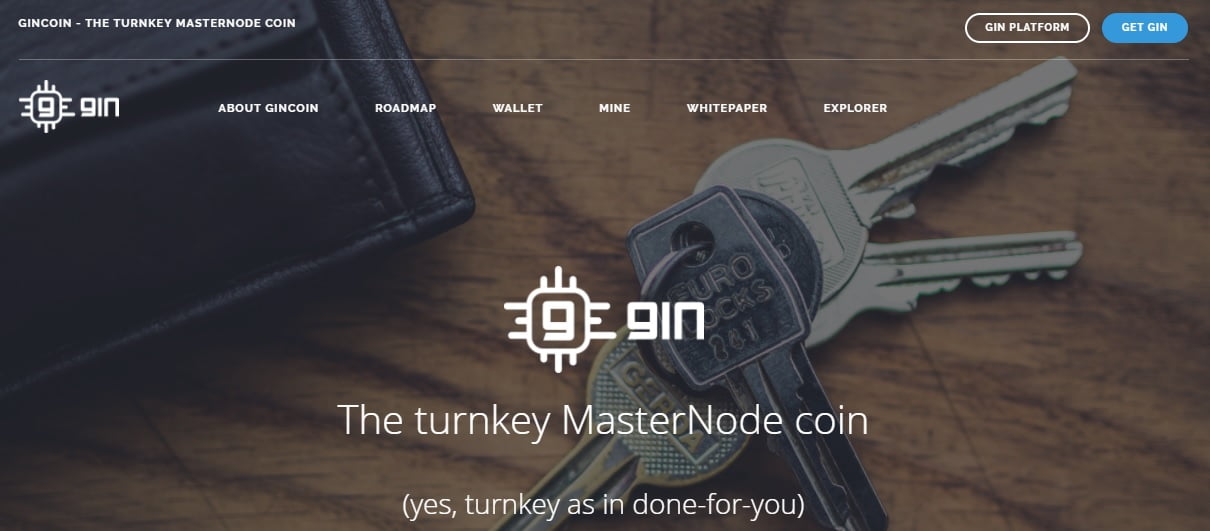A masternode can be thought of as a server that has made its IP address publicly available to third-party actors. However, deploying and running a masternode requires users to possess a high level of technical know-how including a deep understanding of blockchains as well as the ability to launch and maintain a server. Moreover, setting up a masternode also requires considerable economic input from customers.
GINcoin can be described as a peer-to-peer cryptocurrency that provides users with all of the features that Bitcoin has to offer as well as other advantages such as:
- Instant transactions (InstantSend)
- Private transactions (PrivateSend)
- Deployment of masternodes
The ecosystem has been built atop the Dash blockchain and makes use of a GUI-based masternode setup that allows investors to own their very own private masternode. Similar to the architectural framework used by Dash, GINcoin also employs a two-tiered network of miners and masternodes.
The first tier is comprised of the miners who are responsible for creating new blocks, whereas the second tier is made up of masternodes that govern the native PrivateSend, InstantSend and maintenance modules.
Lastly, it is also worth noting that each masternode requires 1,000 GIN as collateral to prevent ‘Sybil’ attacks wherein a peer-to-peer network’s reputation system is compromised by entities with forged identities. The deposited collateral can be spent at any time, but that will result in the deletion of the masternode from the GINcoin network.
Overview of the System
- GINcoin provides users with a masternode setup platform that employs its own native currency to facilitate all internal processes.
- It gives people with no prior experience in programming the ability to deploy a masternode.
- Since owning a masternode requires a substantial initial investment, the company’s developers are looking to extend the platform and accommodate shared masternodes in the near future.
- The UI is visually appealing and quite simple to use.
Key Features
First and foremost, GINcoin provides its users with a service called PrivateSend that allows customers to mix their crypto holdings with other coins before sending them to a wallet in a completely anonymous fashion. The technology is similar to that used by CoinJoin, wherein the platform is able to add multiple modifications to an ongoing transaction by relying on masternodes rather than a single website, as well as restricting the mixing to only accept certain denominations and passive modes of operation.
With that being said, the maximum PrivateSend transaction amount is 1,000 GIN – similar to Dash.

Key aspects of GINcoin
Secondly, owing to its use of a native masternode network, GINcoin provides users with a feature called InstantSend. This functional module helps facilitate near-instant transactions – even though inputs can be locked to specific processes and verified by consensus on the masternode network.
Any conflicting transactions within the ecosystem can be blocked or rejected. If a consensus cannot be reached, validation of the transaction is processed through standard block confirmation processes.

User interface employed by the platform
Lastly, InstantSend also helps alleviate the common issue of double-spending and minimizes long confirmation times to which users of currencies such as Bitcoin are accustomed.
Other important details worth noting about GINcoin include:
- The platform makes use of a mining algorithm called Neoscrypt (and it’s ASIC-resistant)
- The average blocktime for the service currently stands at the 2-minute mark.
How it Works
As mentioned earlier, the GINcoin ecosystem is self-sustaining, i.e., the native currency itself derives value from the platform that it maintains. Besides allowing for free trading on various exchanges, GIN tokens are also employed by community members to cover for and take care of other subsidiary charges including:
- Masternode hosting fees
- Masternode setup fees
- Shared masternode setup fees

Technical information related to the native blockchain
Also worth mentioning is the fact that GIN not only relies on the masternodes of other compatible coins but also helps them grow faster by enabling investors from all walks of life to create, maintain and invest in their own customized masternodes.
According to the official company roadmap, the native platform is already live and available for customers to use. In the next few months, company devs are hoping to modify their service so that it can support a shared masternode framework that will help facilitate increased customer participation.
Token Details
Having been on the market for just over a week, GIN tokens have remained relatively stable in value throughout the course of their short lifespan.

GIN token lifetime performance data (courtesy of CoinMarketCap)
Introduced into the cryptoverse at a price of $6.69 per token, the currency recently peaked at an impressive $9.04. However, since then the price has stabilized, and as of June 1, the value of a single token stands at $7.54.
GINcoin currently possesses a market cap of US$12,065,989. A total of 1,621,063 GIN have been minted, out of which 1,600,693 are currently in circulation.
Final Thoughts
GINcoin provides cryptocurrency investors with an easy way of creating and deploying their own masternode(s), irrespective of their technical prowess. This feature alone makes GINcoin unique, since there are no other projects in the market that fulfill this function.
If you would like to start investing in this venture, GIN trading pairs are currently available on Cryptobridge.

